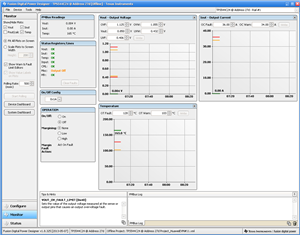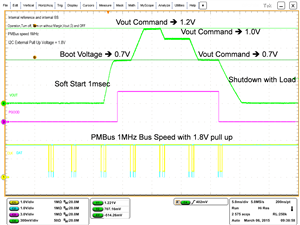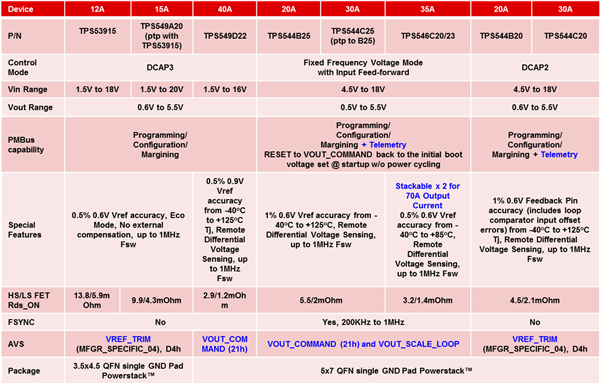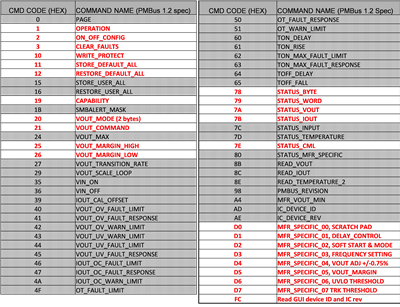SSZTA70 may 2017 LM10011 , TPS549D22
PMBus is an Inter-Integrated Circuit (I2C)-based communication standard/interface for power-supply management. Many point-of-load (POL) converters on the market today are built with the PMBus interface, which enables digital communication between converters and their hosts. The host can be any microcontroller, microprocessor, computer, board-management controller, automatic test equipment or application-specific integrated circuit/field-programmable gate array. There are four general types of communication between the converter and host: command, control, sequence and monitor. A PMBus device can support any combinations of the above communication types.
To know which PMBus device to choose for a particular application depends on the application environment and price point. Generally, PMBus devices designed to provide monitoring functions such as input voltage, input current, output voltage, output current and die temperature have significantly higher silicon and design costs because of the addition of a precision analog-to-digital converter circuit design.
The monitoring capability through PMBus is generally referred to as “telemetry.” Figure 1 shows a graphical user interface (GUI) generated by TI’s Fusion Digital Power™ designer software. The GUI displays three telemetries: output voltage, output current and temperature.
Telemetry is also very useful in systems where data analysis and system characterization are essential. In high-reliability systems where live performance monitoring and failure analysis are absolute musts, the right kind of telemetry can provide great value.
 Figure 1 TI Fusion Digital Power GUI
for Live Telemetry Reading
Figure 1 TI Fusion Digital Power GUI
for Live Telemetry ReadingEven though telemetry is a very useful feature in a PMBus device, not every system or application has the right environment or the need to take advantage of the feature, especially since PMBus devices with telemetry normally cost more than devices without telemetry. But the value and benefit of PMBus is so compelling that even without telemetry, it is still worth your consideration.
One of the major benefits of PMBus is the cost savings that it brings to the overall system bill of materials (BOM). Integrating the PMBus interface into the POL converter eliminates external pin-strapping components that analog designs need to program converter configurations such as switching frequency, current limit, under voltage lockout, soft-start time, power good delay and voltage margining/tracking components.
Figure 2 shows the waveform of adaptive voltage scaling behavior by using the TPS549D22, a 40A PMBus synchronous step-down converter. A voltage identification digital (VID) chip like the TI LM10011 – with several resistors to support the identical voltage scaling functionalities – is necessary to support the series of digital events shown in Figure 2. The PMBus benefit includes not only BOM cost optimization, but also the printed circuit board area reduction achieved by fewer components and routing traces.
 Figure 2 TPS549D22 Digital Events
Driven by a 1MHz PMBus Device
Figure 2 TPS549D22 Digital Events
Driven by a 1MHz PMBus DeviceTI offers several unique high performance and high current converter families. Figure 3 summarizes TI’s PMBus and multi-chip module (MCM) converter products, including the TPS549D22, which is the highest current rated (40A) synchronous buck converter with PMBus, albeit without telemetry. Figure 4 shows the detailed PMBus command sets for the TPS549D22.
 Figure 3 PMBus Converter Selection at a
Glance
Figure 3 PMBus Converter Selection at a
Glance Figure 4 Total PMBus Command Sets
Supported by the TPS549D22
Figure 4 Total PMBus Command Sets
Supported by the TPS549D22Today, PMBus is widely adopted as an effective communication means between the load and its power supply source during design, production test and every day in-system usage. Choosing the right PMBus feature for the power supply application becomes increasingly critical due to multiple considerations contributing to the success of the overall design, including functionality, performance and cost. PMBus without telemetry is still useful when it comes to configuring and controlling all the power sources, and the high integration simplifies design.
For more information on designing with PMBus, read the Power House blogs “PMBus benefits in multi-rail systems,” and “Save PCB space and overcome point-of-load design complexity with PMBus modules.”